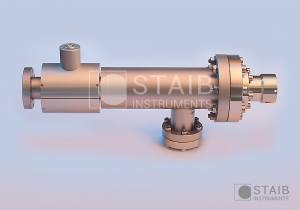 STAIB Instruments offers dedicated solutions tailored to best meet the customer’s requirements
STAIB Instruments offers dedicated solutions tailored to best meet the customer’s requirements
STAIB also offers complete RHEED solutions for different applications especially addressing challenging growth environments and very large substrate sizes.
- Elevated process pressure
- DC magnetic fields originating from the sputter sources
STAIB provides a dedicated solution by combining:
- Single or double differential pumping dependent on the pressure level
- Up to 5×10-3 mbar, single differential pumping
- Up to 0.5 mbar, double differential pumping = TorrRHEED™
- Magnetic shieldings for the beam paths
- Additional beam steering if necessary
- Up to 60 keV to reduce the impact of the magnetic fields involved
STAIB offers assistance in the design phase of sputter deposition systems in order to ensure RHEED compatibility.
- Elevated process pressures
- DC magnetic fields if magnetron sputter sources are used
- Long distances in production systems
- RHEED analysis in multiple spots on the substrate(s), especially in tape deposition systems (i.e. MgO buffer layer)
STAIB provides a dedicated solution by combining:
- Differential pumping
- Magnetic shielding of the beam path (beam guides)
- Additional beam steering if necessary, including 2D scans allowing the RHEED beam position to be changed in parallel from proximal to distal, while maintaining the same incidence angle and azimuth to the substrate
- Parallel beam shift for tape deposition systems and automatized analysis of different substrate positions
- Software control and integration
- RHEED system up to 60 keV
STAIB offers assistance in the design phase of IBAD systems in order to ensure RHEED compatibility.
RHEED analysis in production size deposition systems has to overcome specific challenges:
- Long distances between the electron source and the RHEED screen
- DC magnetic fields if magnetron sputter sources are used
- AC magnetic fields if e-beam evaporators are used
- Elevated pressures (e.g oxide or nitride MBE)
STAIB provides a dedicated solution by combining:
- Differential pumping
- Magnetic shielding of the beam path (beam guides)
- Additional beam steering if necessary
- Software control and integration
STAIB offers assistance in the design phase of production systems in order to ensure RHEED compatibility.
RHEED analysis in combinatorial deposition systems has to overcome specific challenges:
- The deposition on the substrate is not homogeneous throughout the substrate surface. The surface of the grown material shows one or several gradients in X and Y. This requires RHEED analysis in multiple spots on the substrate. Ideally this multiple spot analysis should be time resolved.
STAIB provides a dedicated solution by combining:
- Differential pumping (if necessary)
- Parallel beam shift and automatized analysis of different substrate positions
- 2D scans allowing the RHEED beam position to be changed in parallel from proximal to distal, while maintaining the same incidence angle and azimuth to the substrate
- Multiple spot analyses with high repetition rate
- Software control and acquisition of multiple data sets
- RHEED system of 30 keV and higher
STAIB offers assistance in the design phase of combinatorial growth systems in order to ensure RHEED compatibility.
RHEED analysis in ALD (Atomic layer deposition) systems has to overcome specific challenges:
- DC magnetic fields if magnetron sputter sources are used
- Elevated pressures
STAIB provides a dedicated solution by combining:
- Differential pumping
- Magnetic shielding of the beam path (beam guides)
- Additional beam steering if necessary
- Software control and integration
STAIB offers assistance in the design phase of ALD systems in order to ensure RHEED compatibility.
MicroRHEED:
- RHEED analysis with high lateral resolution
STAIB offers the MicroRHEED 15 for this application
- Beam diameter at the sample is smaller than 10 µm
